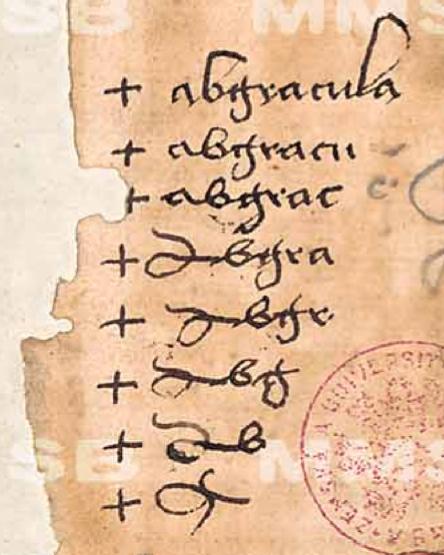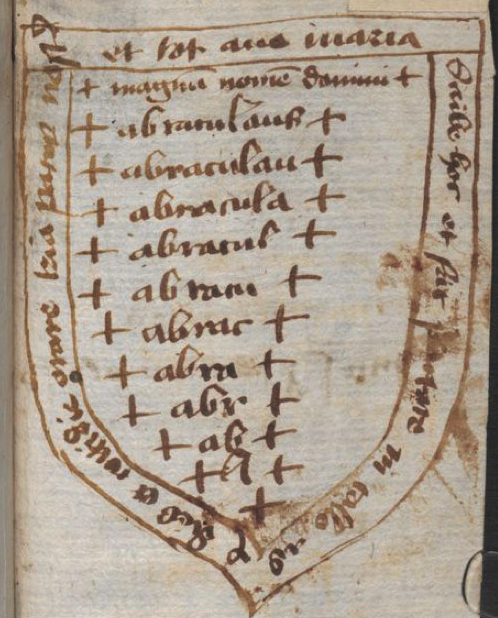The Charm of the Voynich, cont’d
In a previous post, I commented on the charm-like text written on the final page of the Voynich manuscript and since that time had a surprise… In October 2015, I discovered a page in a mid-15th century codex that resembles and expands on the information written on a fragment at the beginning of Der Neusohler Cato that I discussed in relation to the VM text.
 In the Cato, the fragment on the left illustrates an abracadabra-style word (abgracula) broken down until it resembles a symbol that I imagine could be included on an amulet or hilt of a sword or dagger. I don’t know if that was its function, it could be an incantation for “reducing” the severity of an illness, like a prayer (with the crosses perhaps signifying the signing of the cross while speaking the incantation) or something else. This was only a hunch, when I first saw it, since the Cato fragment contained few clues to its function.
In the Cato, the fragment on the left illustrates an abracadabra-style word (abgracula) broken down until it resembles a symbol that I imagine could be included on an amulet or hilt of a sword or dagger. I don’t know if that was its function, it could be an incantation for “reducing” the severity of an illness, like a prayer (with the crosses perhaps signifying the signing of the cross while speaking the incantation) or something else. This was only a hunch, when I first saw it, since the Cato fragment contained few clues to its function.
Since then, I discovered another version of the same charmlike text, contained within a shape that resembles a shield, with writing in the shield margins.
Comparisons between the Cato Fragment and the Fugger Text
There are some differences. The ink is much darker in the Cato fragment and the handwriting more spidery and awkward. The writing style is a fairly common one for the 15th century in this region, so while it is similar, it’s probably not in the same hand, especially considering the different rendering of the letter r and the way it joins to the following letter.
As for the content, the Cato fragment begins with abgracula and the Fugger codex with magnum nomen dominum (“In the name of the Father”) followed by abraculauß on the second line. Also, the Cato fragment breaks down to an amulet-style symbol while the Fugger text retains the letter shapes to the end. Despite differences, the resemblance is clear, with the crosses and progression of sounds broken down in the same general way.
The text around the margins of the shield appear to be a mixture of old Germanic and Latin and unfortunately, some of it is smeared. On the right, it appears to say, “The writing pertains to p???tate…” (“The writing is for p???tate…”). Could the unclear word be “prostate” (as in a prostrate person, someone lying down due to illness or impending death? Or does it perhaps say praetare, plaetare or photare or something along those lines (maybe someone who knows Latin can make it out). I’m wondering if it’s a variation of praeterea. I refer to the text before the “photare/photate” as Germanic because it’s not strictly German, but is readable as northern old German. On the opposite side of the shield is text about praying Our Father (pater noster).
It doesn’t seem like a traditional last rights incantation which is why I wonder if it’s perhaps a sick-bed incantation/prayer.
Connections to the Voynich Manuscript
How this ties into the Voynich manuscript is that the last page struck me as having an incantation-like quality (long before I knew anything about medieval charms) and the above example lends some weight to that possibility. Also note that the VM charm appears to be a mixture of Latin-like sounds and Germanic words and the handwriting in this abraculauß text is from the same writing tradition as the last page and some of the marginal notes in Beinecke 408—a handwriting style* that is primarily concentrated in northeast Switzerland and southwest Germany at about the same time as Sagittarius with legs and a crossbow was popular, but which also found its way (with a handful of modifications) to a monastery in mideast England, probably through one or more traveling monks.
There was a commercial workshop in central Europe in the 1400s producing religious texts and chronicles for those who could afford them and the head of the studio was also a writing tutor, so it’s not surprising that there are quite a few manuscripts from this area with very similar handwriting.
*(When commercial block prints and the printing press came along, this specific style of writing died out and medieval scribes had to find a new line of work.)
J.K. Petersen
© Copyright 2015 J.K. Petersen, All Rights Reserved

